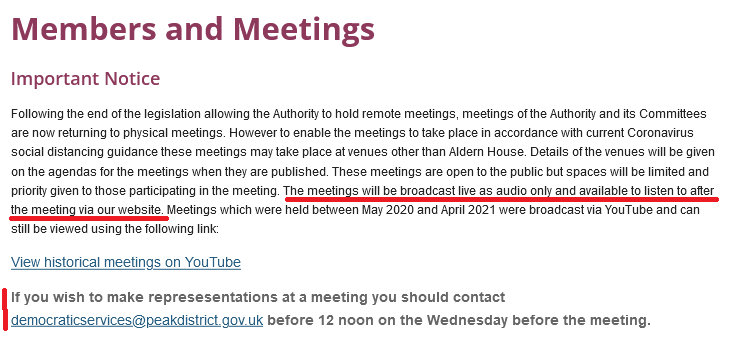On Tuesday Raptor Persecution UK had an excellent guest blog from Bob Berzins about the persecution of raptors in the Peak District National Park (see here). This explained that part of the reason for the National Park Authority’s failure to address this illegal persecution is a lack of transparency and accountability to the public, particularly as regard their relationships with landowners and sporting interests.
Similar issues are evident in both of Scotland’s National Park Authorities, with neither for example openly publishing how much public money they are awarding landowners for peatland restoration schemes. But, unlike Scotland’s National Parks, Mr Berzins was able to refer readers to a recording of a meeting to back up his argument and provide evidence of how little understanding some board members have of conservation issues.
Differences in the governance of Scottish and English National Parks
While meetings of both the Cairngorms National Park Authority (CNPA) and Loch Lomond and Trossachs National Park Authority (LLTNPA) are now both broadcast live and it would be easy enough to publish those recordings on their website, if a member of the public cannot give up time during the day to watch those meetings, that’s it.
By contrast:

Extract from the Peak District National Park Authority (PDNPA) website (see here).
While the PDNPA website states that only audio recordings are available, in fact the meetings held this month are all on Youtube. It’s the same with the Lake District National Park Authority (LDNPA). It is not just recording of the main board meetings the public can view, its all their subcommittees too.
The PDNPA also provides emails for all Board Members, like the LDNPA, while some local appointees also provide home addresses and telephone numbers too! One just has to hope that National Parks in England are not influenced by James Stuart, the Convener of the LLTNPA who is now on the LDNPA board. He has resisted all calls to give LLTNPA Board Members contact emails, despite being provided with one by the LDNPA (see here), and refuses to keep recordings of board meetings in the public realm.
There are several other differences in the governance of the PDNPA that make it more transparent and accountable than Scotland’s National Parks:
- Frequency of meetings. The PDNPA has eight board meetings scheduled each year, that is twice the number in the LLTNPA and CNPA (though in practice the CNPA holds more). Meetings are good for democracy and means fewer decisions are delegated to staff.
- Under the meetings section of its website (extract above), the PDNPA highlights that the public can make representations to the board. While the LLTNPA’s Standing Orders contain provisions for this – which I have used on one occasion – this facility is not advertised to the public. It’s little use if hardly anyone knows about it. The CNPA’s board standing orders contain no facility for the public to make representations although the Convener can invite people to meetings and could possibly use that facility to allow representations. (There is provision for objectors to planning applications to make representations to the planning committee)
- The other excellent facility under the board members section of the PDNPA website is this:

A couple of clicks and you can see what meetings a board member has attended whereas in the LLTNPA, for example, this information is only provided in annual reports by which time it is often too late. Unless you had viewed both the LLTNPA’s additional board meeting on the Loch Long fishfarm and the December board meeting you would not know that Hazel Sorrell, the new nominee from West Dunbartonshire Council, had missed both meetings. Information about board member “performance” that is made accessible by the PDNPA is hard to find or missing on the LLTNPA and CNPA websites.
The Scottish Government and Scottish Parliament have long prided themselves on doing things better than down in England, including doing more to address climate change and the nature crisis. I wish that was true. Instead, when it comes to National Parks, there is unfortunately very little difference. Neither the CNPA or PDNPA, for example, has done anything significant to end the unlawful killing of raptors.
In terms of transparency and accountability, however, it is time our politicians realised that Scotland’s National Parks are third rate and that these deficits need to be addressed. When is Lorna Slater, the Green MSP who has been in charge of National Parks for a year and a half now, going to act?
